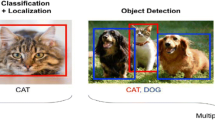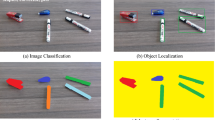Abstract
Segmenting objects from images is an important but highly challenging problem in computer vision and image processing. This paper presents an automatic object segmentation approach based on principal pixel analysis (PPA) and support vector machine (SVM), namely PPA–SVM. The method comprises three main steps: salient region extraction, principal pixel analysis, as well as SVM training and segmentation. We consider global saliency information and color feature by means of visual saliency detection and histogram analysis, such that SVM training data can be selected automatically. Experiment results on a public benchmark dataset demonstrate that, compared with some classical segmentation algorithms, the proposed PPA–SVM method can effectively segment the whole salient object with reasonable better performance and faster speed.







Similar content being viewed by others
References
Hiremath PS, Jagadeesh P (2008) Content based image retrieval using color boosted salient points and shape features of an image. Int J Image Process 2(1):1–34
Guo CL, Zhang LM (2010) A novel multiresolution spatiotemporal saliency detection model and its applications in image and video compression. IEEE Trans Image Process 19(1):185–198
Yu Y, Mann GKI, Gosine RG (2010) An object-based visual attention model for robotic applications. IEEE Trans Syst Man Cybern B Cybern 40(5):1398–1412
Li H, Ngan KN (2008) Saliency model based face segmentation in head-and-shoulder video sequences. J Vis Commun Image Represent 19(5):320–333
Tsotsos JK, Culhane SM, Wai WYK, Lai Y, Davis N, Nuflo F (1995) Modelling visual attention via selective tuning. Artif Intell 78(1–2):507–545
Cheng MM, Zhang GX, Mitra NJ, Huang X, Hu SM (2011) Global contrast based salient region detection, CVPR 21–23
Itti L, Koch C, Niebur E (1998) A model of saliency based visual attention for rapid scene analysis. IEEE Trans Pattern Anal Mach Intell 20(11):1254–1259
Harel J, Koch C, Perona P (2007) Graph-based visual saliency. Adv Neural Inf Process Syst 19:545–552
Lin Y, Fang B, Tang Y (2010) A computational model for saliency maps by using local entropy. Proc Conf AAAI Artif Intell 967–973
Walter D, Koch C (2006) Modelling attention to salient proto-object. Neural Netw 19(9):1395–1407
Valenti R, Sebe N, Gevers T (2009) Images saliency by isocentric curvedness and color, ICCV 2185–2192
Ma YF, Zhang HJ (2003) Contrast-based image attention analysis by using fuzzy growing. International conference on multimedia, pp 374–381
Liu T, Yuan Z, Sun J, Wang J, Zheng N, Tang X, Shum HY (2011) Learning to de tect a salient object. IEEE Trans Pattern Anal Mach Intell 33(2):353–367
Hou X, Zhang L (2007) Saliency detection: a spectral residual approach, CVPR 1–8
Guo C, Ma Q, Zhang L (2008) Spatio-temporal saliency detection using phase spectrum of quaternion fourier transform, CVPR 1–8
Achanta R, Hemami S, Esgtrada F, Süsstrunk S (2009) Frequency-tuned salient region detection, CVPR 1597–1604
Rosin PL (2009) A simple method for detecting salient regions. Pattern Recognit 42(11):2363–2371
Luo W, Li H, Liu G, Ngan KN (2011) Global salient information maximization for saliency detection. Sig Process Image Commun 27(3):238–248
Yang W, Tang Y, Fang B, Shang Z, Lin Y (2013) Visual saliency detection with center shift. Neurocomputing 103(1):63–74
Ouerhani N, Archip N, Hügli H, Erard PJ (2001) Visual attention guided seed selection for color image segmentation. Proceedings of the 9th international conference on computer analysis of image and patterns, lecture notes in computer science, vol 2124, Springer, London, pp 630–637
Han J, Ngan KN, Li M, Zhang HJ (2006) Unsupervised extraction of visual attention objects in color images. IEEE Trans Circuits Syst 16(1):141–145
Ko BC, Nam JY (2006) Object-of-interest segmentation based on human attention and semantic region clustering. J Opt Soc Am A 23(10):2462–2470
Achanta R, Estrada F, Wils P, Süsstrunk S (2008) Salient region detection and segmentation. In: Proceedings of the 6th international conference on computer vision systems, lecture notes in computer science, vol. 5008, Springer, Berlin pp 66–75
Donoser M, Urschler M, Hirzer M, Bischof H (2009) Saliency driven total variation segmentation, ICCV 817–824
Liu Z, Li W, Shen L, Han Z, Zhang Z (2010) Automatic segmentation of focused objects from images with low depth of field. Pattern Recognit Lett 31(7):572–581
Lee CY, Leou JJ, Hsiao HH (2012) Saliency-directed color image segmentation using modified particle swarm optimization. Signal Process 92(1):1–18
Liu Z, Shen L, Zhang Z (2011) Unsupervised image segmentation based on analysis of binary partition tree for salient object extraction. Signal Process 91(2):290–299
Zhu R, Yao M, Liu YM (2011) A two-level strategy for segmenting center of interest from pictures. Expert Syst Appl 38(3):1748–1759
Fu K, Gong C, Yang J, Zhou Y, Gu IYH (2013) Superpixel based color contrast and color distribution driven salient object detection. Signal Process Image Commun 28(10):1448–1463
Vapnik VN (1995) The nature of statistical learning theory. Spring, New York
Yu Z, Wong HS, Wen G (2011) A modified support vector machine and its application to image segmentation. Image Vis Comput 29(1):29–40
Wang XY, Wang T, Bu J (2011) Color iamge segmentation using pixel wise support vector machine classification. Pattern Recognit 44(4):777–787
Saha I, Maulik U, Bandyopadhyay S, Plewczynski D (2012) SVMeFC: SVM ensemble fuzzy clustering for satellite image segmentation. IEEE Trans Geosci Remote Sens 9(1):52–55
Zhao Q, Hu Y, Cao J (2009) Automatic image segmentation based on saliency maps and Fuzzy SVM, CCWMC 121–124
Castleman KR (1996) Digital image processing, second ed. Prentice Hall, New York
Wang P, Wang J, Zeng G, Feng J, Zha H, Li S (2012) Salient object detection for searched web images iva global saliency. In CVPR, 3194–3201
Brigger P, Casas JR, Pardas M (1996) Morphological operators for image and video compression. IEEE Trans Image Process 5(6):881–898
Chen TW, Chen YL, Chien SY (2008) Fast image segmentation based on K-means clustering with histograms in HSV color space. IEEE workshop multimed. Signal Proc pp 322–325
Zhang L, Lin FZ, Zhang B A CBIR method based on color-spatial feature, Technical report, Department of Computer Science and Technology, Tsinghua University, Beijing 100084, China
MacQueen JB (1967) Some methods for classification and analysis of multivariate observations. Proceedings of the 5th Berkeley symposium on mathematical statistics and probability 2:281–297
Shi J, Malik J (2000) Normalized cuts and image segmentation. IEEE Trans Pattern Anal Mach Intell 22(8):888–905
Rother C, Kolmogorov V, Blake A (2004) “Grabcut”–interactive foreground extraction using iterated graph cuts. ACM Trans Graph 23(3):309–314
Chang CC, Lin CJ (2011) LIBSVM: a library for support vector machines. ACM Trans Intell Syst Technol 2(3):1–27. (http://www.csie.ntu.edu.tw/cjlin/libsvm)
Unnikrishnan R, Pantofaru C, Hebert M (2007) Toward objective evaluation of image segmentation algorithms. IEEE Trans Pattern Anal Mach Intell 29(6):929–943
Meila M (2005) Comparing clusterings: an axiomatic view. ICML 577–584
Martin D, Fowlkes C, Tal D, Malik J (2001) A database of human segmented natural images and its application to evaluating segmentation algorithms and measuring ecological statistics, ICCV 416–425
Wang XZ, Dong CR (2009) Improving generalization of fuzzy if-then rules by maximizing fuzzy entropy. IEEE Trans Fuzzy Syst 17(3):556–567
Wang XZ, Zhai JH, Lu SX (2008) Induction of multiple fuzzy decision trees based on rough set technique. Inf Sci 178(16):3188–3202
Zhai JH, Xu HY, Wang XZ (2012) Dynamic ensemble extreme learning machine based on sample entropy. Soft Comput 16(9):1493–1502
Acknowledgments
The work described in this paper was partially supported by the National Natural Science Foundation of China (No. 61273291), Research Project Supported by Shanxi Scholarship Council of China (No. 2012-008), Scientific and Technological Project of Shanxi Province (No. 20120321027-01), Open Project Foundation of Information Technology Research Base of Civil Aviation Administration of China (No. CAAC-ITRB-201305).
Author information
Authors and Affiliations
Corresponding author
Rights and permissions
About this article
Cite this article
Bai, X., Wang, W. Principal pixel analysis and SVM for automatic image segmentation. Neural Comput & Applic 27, 45–58 (2016). https://doi.org/10.1007/s00521-013-1544-2
Received:
Accepted:
Published:
Issue Date:
DOI: https://doi.org/10.1007/s00521-013-1544-2




